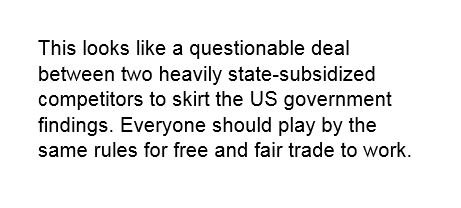Analysis: Airbus Acquires 50% of Bombardier CSeries

MIAMI — Airbus and Bombardier announced a blockbuster joint venture agreement Monday evening, as the European aircraft manufacturing giant will acquire a majority stake in the Canadian planemaker’s innovative but financially troubled CSeries jet.
Bombardier has already spun off the CSeries program from its other aerospace and transport business lines into the CSeries Aircraft Limited Partnership (CSALP), which manufactures and sells the 100-130 seat CSeries family of jets.
After the acquisition, Airbus will own 50.01% of CSALP, while Bombardier will own 31%. The remaining 19% will be owned by Investissement Québec (IQ), the investment arm of the Québec state government.

The headquarters of CSALP will remain in Québec (in the Montréal metro area) as will the primary final assembly line (FAL), but the partnership will add a second (FAL) in Mobile, Alabama to serve U.S. customers. However, the underlying supply chain for the aircraft will change as Airbus takes over procurement, likely utilizing Airbus’ much larger resources.
As part of it’s controlling stake, Airbus will enter into commercial agreements covering sales and marketing support for the CSeries, management of procurement and suppliers, and customer support.
It will not outlay any cash, nor will CSALP take on any debt. In fact, Bombardier’s current funding plan for CSALP will be maintained, and Bombardier will fund any CSALP cash shortfalls over the first year of up to $350 million and up to $350 million over the next two years as well.
The transaction also includes warrants for Airbus to acquire a 5% stake in Bombardier at the current share price (essentially an option for Airbus to acquire 5% of Bombardier at any point in the next five years). The transaction is subject to regulatory approval and is expected to be completed in the second half of 2018.
THE DEAL RE-SHAPES GLOBAL AVIATION
It is not at all hyperbolic to say that this may be the most impactful commercial aircraft acquisition since the Boeing-McDonnell Douglas merger in 1998.

The Boeing 717 was originally marketed as the McDonnell-Douglas MD-95 before the company merged with Boeing in 1997. (Credits: Author)
It may arguably be more impactful given the context of the current commercial aircraft duopoly at the high end. Simply put, the CSeries gives Airbus a strategic edge over Boeing by opening up an additional market for 6,000 new jets over the next 20 years between 100-150 seats.
With the addition of the CSeries, Airbus now becomes a literal one stop shop for any airline’s short-haul fleet needs. It can sell you an ATR 72 turboprop for short regional flights (Airbus owns 50% of ATR), the CS100 for high-frequency and longer regional flights, the CS300 for small mainline flying and long and thin missions, the A320neo for the core of your mainline fleet, and the A321neo for the middle of market (MOM) space.

Bombardier’s marketing strategy for its CSeries program directly compares it against Boeing’s 737 Family. Meanwhile, Boeing can sell you the 737 MAX 8 as the centerpiece of your fleet and the 737 MAX 10 to cover your MOM needs if you don’t need more than 2,800 nautical miles of range. Airbus already had an advantage over Boeing on the narrowbody side of the house – this CSeries joint venture exacerbates that.
With the addition of the CSeries, it is now credible to believe that Airbus will outsell Boeing by a margin of 60-40 or even 65-35 in the narrowbody space over the next 20 years (the current generation of aircraft).
IS THE CSERIES AIRBUS’ SMALLER MAINLINE PLATFORM?
Bombardier has long had studied the possibility of stretching the CS300 to a ~160 seat CS500, a plane that would have substantially improved operating economics over the A320neo and 737 MAX 8 on paper even without a re-engine.
Given that the market is moving upstream, Airbus can now credibly decide that its future narrowbody lineup will consist of a re-engined CS100, a re-engined CS300, and a CS500 stretch with new engines.
This would allow it to dedicate development dollars to building a true MOM clean sheet plane to combat Boeing’s plans in that arena, with an A321-sized jet as the base model. In contrast, Boeing will likely have to build two clean sheet planes: a new MOM jet (the 797?) and a new small airplane (NSA) to replace the Boeing 737 family.
BOMBARDIER GETS THE PARTNER IT NEEDS WHILE BOEING HAS TO GO BACK TO THE DRAWING BOARD
After the recent decision by the US Department of Commerce to slap a massive 300% tariff on Bombardier’s sale of 75 CS100s to Delta Air Lines, it became clear that a standalone Bombardier was going to struggle to find its financial footing with the U.S. market blocked off.
At the time, we theorized that a potential deal with the Chinese state-owned manufacturer COMAC could be on the table, but it turns out that an Airbus deal was in the works.
In Airbus, Bombardier gets a partner with immense sales reach (even after the retirement of lead pitchman John Leahy) and credibility. It will also be able to bring down production costs on the CSeries quicker thanks to Airbus taking over procurement, and there could be some synergies (and commiseration) surrounding the Pratt & Whitney geared turbofan (GTF) engines that power both the CSeries and the A321neo.
Best of all, thanks to reciprocal treaties, the US can’t impose tariffs on Airbus products while the EU can’t do the same to Boeing products. This unlocks the US market for Bombardier once more and shuts the book on the Delta tariffs. Perhaps this is why Delta CEO Ed Bastian was so confident that his carrier wouldn’t be paying the tariffs on Delta’s Q3 earnings call last week.

Meanwhile, Boeing now has to go back to the drawing board. The US market is once again unlocked for the CSeries, now with Airbus’ sales might behind it. JetBlue will almost certainly buy the CSeries as an E190 replacement, and American and United may well be enticed into taking another look at the small mainline jet. There are also no easy answers for Airbus’ upgraded product lineup.
Embraer is pretty much the only credible small mainline jet manufacturer left (COMAC and UAC/Sukhoi are state owned by the Chinese and Russian governments respectively).
Does Boeing now try to do a deal with Embraer?
At the very least a commercial agreement covering sales and marketing could be beneficial, and it would allow Boeing to close the product gap with Airbus somewhat. But either way, this blockbuster deal very much puts Boeing on the back foot.



No comments:
Post a Comment